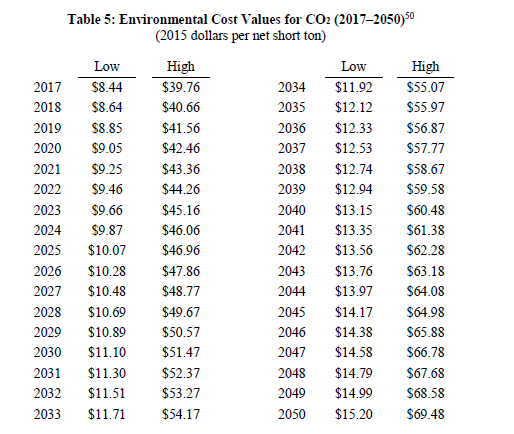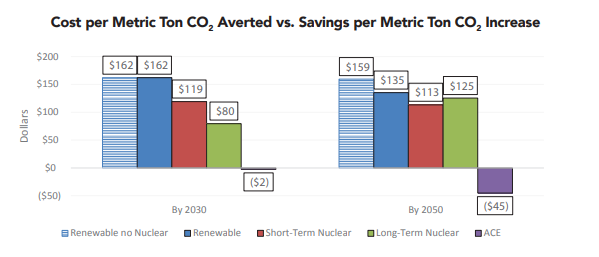Doubling Down on Failure Installment Four: Renewable Energy Fails Cost/Benefit Analysis Using Minnesota Public Utilities Commission Social Cost of Carbon
This article is the fourth installment explaining the findings of our new study entitled Doubling Down on Failure, How a 50 percent by 2030 Renewable Energy Standard Would Cost Minnesota $80.2 Billion.
This installment explains how the cost of reducing carbon dioxide emissions under the Renewable, Short-Term Nuclear, and Long-Term Nuclear would exceed the Social Cost of Carbon (SCC) established by the Minnesota Public Utilities Commission (PUC). The Affordable Clean Energy (ACE) scenario, is the only scenario that passes this cost-benefit analysis.
This post is pretty in the weeds, so the main takeaway is that the costs of reducing our carbon dioxide emissions greatly outweigh the benefits.
Now, a little background.
The PUC was instructed to determine a monetized cost for each ton of carbon dioxide emitted by Minnesota power plants. In other words, the PUC was supposed to calculate the damages caused by each ton of carbon dioxide emitted into the air. After a year’s-long process, which involved input from each of the state’s investor owned utilities, the PUC came up with their SCC estimates, which are shown in the table below.
Of course, Xcel Energy lobbied for the highest SCC value so they could build more wind turbines and solar panels, but that’s a discussion for another day.

As you can see, the Social Cost of Carbon established by the PUC in 2050 ranges from $15.20 through $69.48.
This is noteworthy, because the cost of reducing one metric ton of carbon dioxide while providing reliable electricity under the Renewable scenario would be $135 per metric ton if Minnesota’s existing power plants remain in operation, and a whopping $159 per ton if the nuclear plants close down.
This means the cost of reducing carbon dioxide emissions using wind and solar would be 1.94 to 8.88 times (or 194 percent to 888 percent) more expensive than the cost of the carbon dioxide itself if the nuclear plants remain open and 2.3 to 10.4 times (230 percent to 1040 percent) more expensive if the nuclear plants are shut down.
This means using renewable energy to reduce carbon dioxide emissions would unequivocally flunk a cost benefit analysis.

Furthermore, although the Short-Term Nuclear and Long-Term Nuclear scenarios would be less expensive than using renewables, the costs of switching to nuclear power would also outweigh the SCC values established by the PUC.
Only the ACE scenario, which calculates the monetary savings reaped by Minnesota households for each additional ton of carbon dioxide emitted into the atmosphere, relative to a 2016 baseline, passes any semblance of a cost benefit analysis. By saving consumers $45 per additional ton of CO2 emitted by utilizing existing coal plants, the benefits accrued under the ACE scenario are approximately three times greater than the low end SCC estimates, and only 35 percent less than the high-end estimates.
Compare that to the fact that the Renewable scenario would costs 194 percent more than the SCC, on the low end, and 888 percent more on the high end, and it becomes abundantly clear the most rational thing to do is to utilize our existing coal and natural gas plants for the remainder of their existing lifetimes and then look at other options, like nuclear power, when the time comes.
Now, there are legitimate reasons to argue that the Social Cost of Carbon estimates established by the PUC are too high, and this weakens the case for the Renewable scenario even more.
When calculating the SCC, the PUC took global benefits, into consideration, rather than estimating the benefits accrued to Minnesotans. The Trump Administration has issued it’s own SCC estimates, using only benefits accrued in the United States, and using a discount rate of 7 percent, and concluded the SCC for the United States should be priced much lower. In fact, these two simple changes result in SCC values ranging from $1 to $6 by 2020, far less than those estimated by the PUC, which adhered more closely to methods used by the Obama administration.
These SCC estimates would be even smaller if we calculated them specifically for Minnesota. Essentially, lawmakers who are pushing for more renewable energy want you to pay $135 for less than $1 in benefits.
In the end, the result is the same whether you think the PUC’s estimate for the SCC is more appropriate or whether you favor the estimates of the Trump administration: the economic costs of reducing CO2 far outweigh the theoretical benefits of doing so.